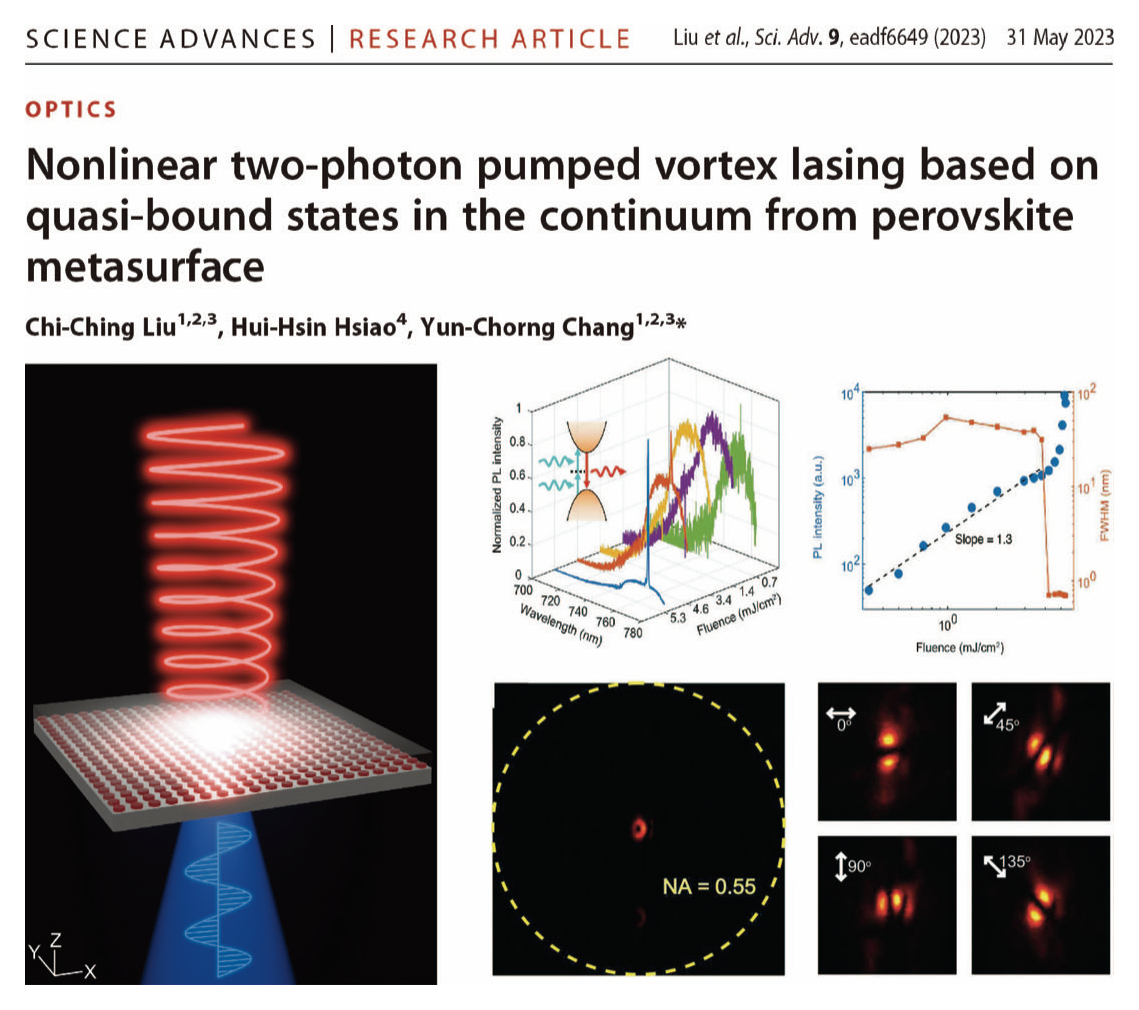RCAS Researchers demonstrated the first two-photon pumped vortex lasing based on quasi-bound states in the continuum from perovskite metasurface
RCAS researchers, Prof. Yun-Chorng Chang and his Ph.D. student (Mr. Chi-Ching Liu) teamed up with Prof. Hui-Hsing Hsiao from National Taiwan University and have successfully demonstrated the world’s first two photon-pumped vortex lasing from perovskite metasurface based on the bound states in the continuum (BIC). BIC is currently a hot research topic in Nanophotonics.
In this research, the research team successfully developed a new process to fabricate the necessary
perovskite metasurface. Due to the excellent nonlinear optical properties of perovskite, the team also successfully demonstrated the first demonstration of nonlinearly pumped QBIC lasing from the perovskite metasurface. The vortex lasing provides new freedom for applications in optical communication or quantum communication.
Summary of Achievement
We successfully use the modified electron-beam lithography (EBL) to fabricate perovskite metasurface and observe photo-pumped vortex lasing based on bound states in the continuum, which is a hot research topic in Nanophotonics. In this research, we have succeeded to report the 1st observation of two-photon pumped vortex lasing from the perovskite metasurface. In addition, we also discovered that the lasing can be modulated by varying the laser spot size. The vortex lasing provides new freedom for applications in optical communication or quantum communication.
New Discovery or Breakthrough
We have to modify conventional electron-beam lithography first in order to fabricate the necessary perovskite metasurface, which is the first scientific breakthrough in this research. We also took advantage of the excellent non-linear optical properties of perovskite material and achieved two-photon pumped vortex lasing, which has not been demonstrated in the literature. In addition, we also discovered the lasing can be modulated by varying the laser spot size, which has been referred as “finite array size effect”in this study.
Motivation
The original idea for this research is to develop a modified electron-beam lithography that is capable of fabricating perovskite nanostructures for some other experiments. However, Chi-Ching fabricated several additional square nanodisk arrays when performing the EBL. His original idea is to observe photo-pumped lasing from the perovskite nanodisk arrays, which is very similar to the experimental results reported by Prof. Teri Odom at Northwestern University. After we observed the photo-pumped lasing, we were not sure what is the uniqueness of this result and have consulted many others professors about what we can improve for a possible journal publication. After listening to Prof. Kuo-Ping Chen’s (National Tsing Hua University) talk about the concept of bound states in the continuum, we started to realize that the observing the lasing originated from BIC. Chi-Ching then started to read more about BIC and perform all the necessary measurement to verify that the observed lasing originated from BIC.
Working Footprint
TIn this work, we have to develop the necessary fabrication procedures of the perovskite nanostructures, measured the photo-pumped lasing from the perovskite metasurface, and then used theoretical simulation to verify the vortex lasing originated from Bound states in the continuum all by ourselves. The overall duration for this study lasted for more than two years.
Collaborators
We are a research group that is specialized in developing the nanofabrication procedures and the synthesizing the perovskite materials. However, BIC is a brand-new concept in Nanophotonics and we have very limited knowledge about BIC. We have to spend much of our effort to perform theoretical modeling in order to understand more about BIC. Prof. Hsiao from the department of Engineering Science and Ocean Engineering in National Taiwan University is an expert in this field and has helped us a lot in this direction. Therefore, Prof. Hsiao is also a co-author in this journal publication.
Breakthrough Methodology
Our method to synthesize perovskite materials was a very special process so we have spent much time to optimize the parameters. In addition, we also have to modify the EBL because perovskite was easily damaged by the electron beam. In addition, we also need to develop the specific procedures to verify whether the lasing originated from BIC.
Difficulties
BIC is a brand-new concept in the field of Nanophotonics, which was very difficult for a team specialized in experimental physics to understand. Therefore, we have to spend much effort to understand the necessary theories by ourselves during the investigation.
Applications
Vortex lasers offer new freedom for optical manipulation, which can be applied the field of quantum computing and communication. In addition, the directional emission of the BIC lasing can also be used in the field of optical communication and integration optics.
Acknowledgement
The majority research effort in this study, including the performing the experimental measurements and the theoretical analysis, were accomplished by the 1st author, Mr. Chi-Ching Liu. It was such a privilege to be able to work with him in this study and observed his growth into an independent researcher over the last few years.
Future Directions
Our next step for this study is to achieve electric-pumped lasing. In addition, we will also look to obtain vortex lasing for higher winding number.
Behind the Screen
In the beginning of this research, Chi-Ching has observed a very strange phenomenon. When he focused the laser to a minimum spot during the confocal PL measurement, he cannot detect the lasing signal. The lasing signal can only be detected when he slightly defocused the laser spot. This contradicted to our common physics intuition. We asked the company to confirm the confocal PL system was well-aligned. Since we have no idea what was happening, we decided to ignore this phenomenon and move on.
As we became more familiar to the concept of BIC, we started to believe this abnormal phenomenon can be explained by BIC. Later, we proposed that the BIC lasing threshold is related to the excitation spot size, which was referred as “finite array size effect”. This is also the first report to propose the BIC lasing can be modulated by the excitation spot size.
